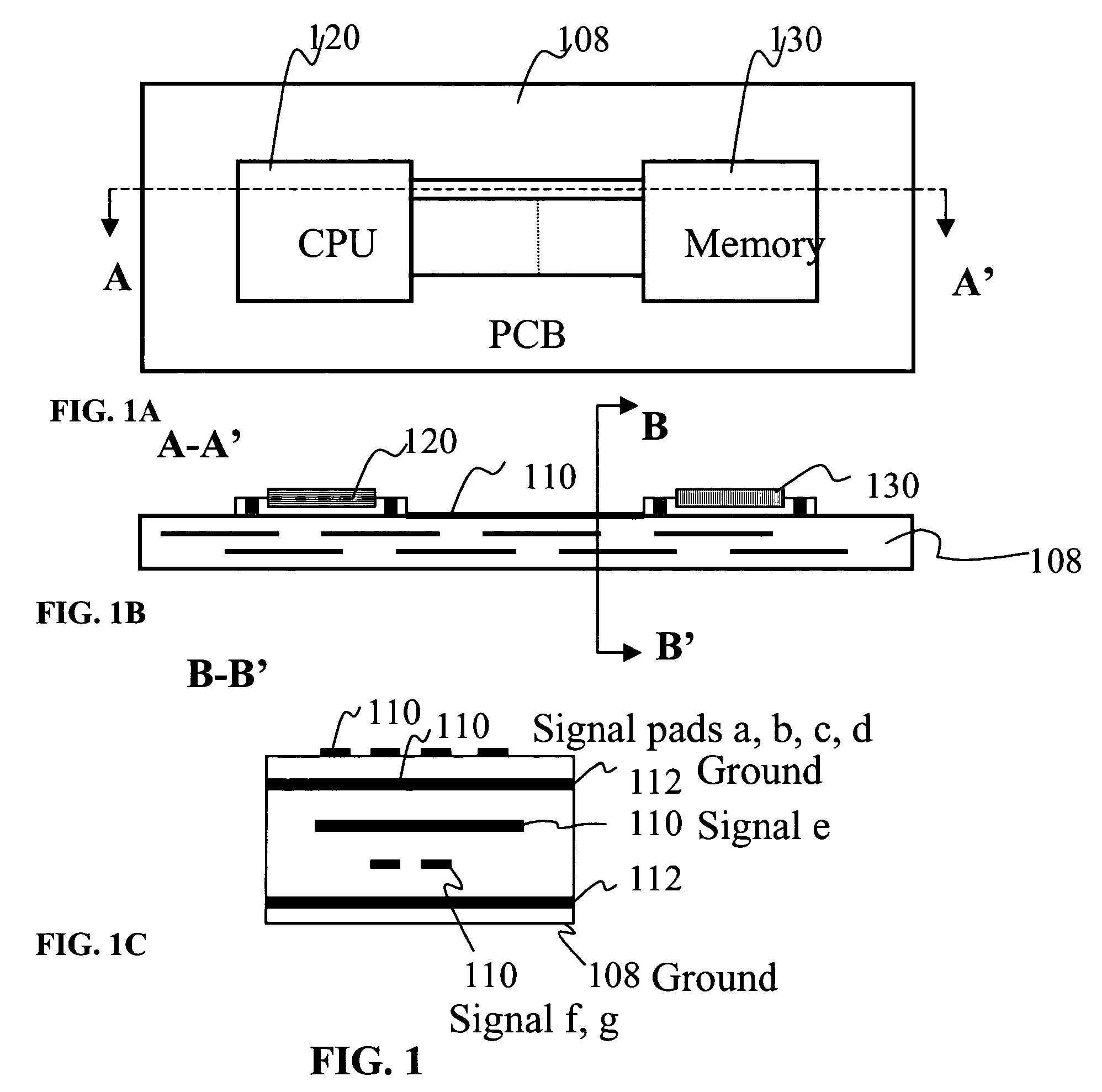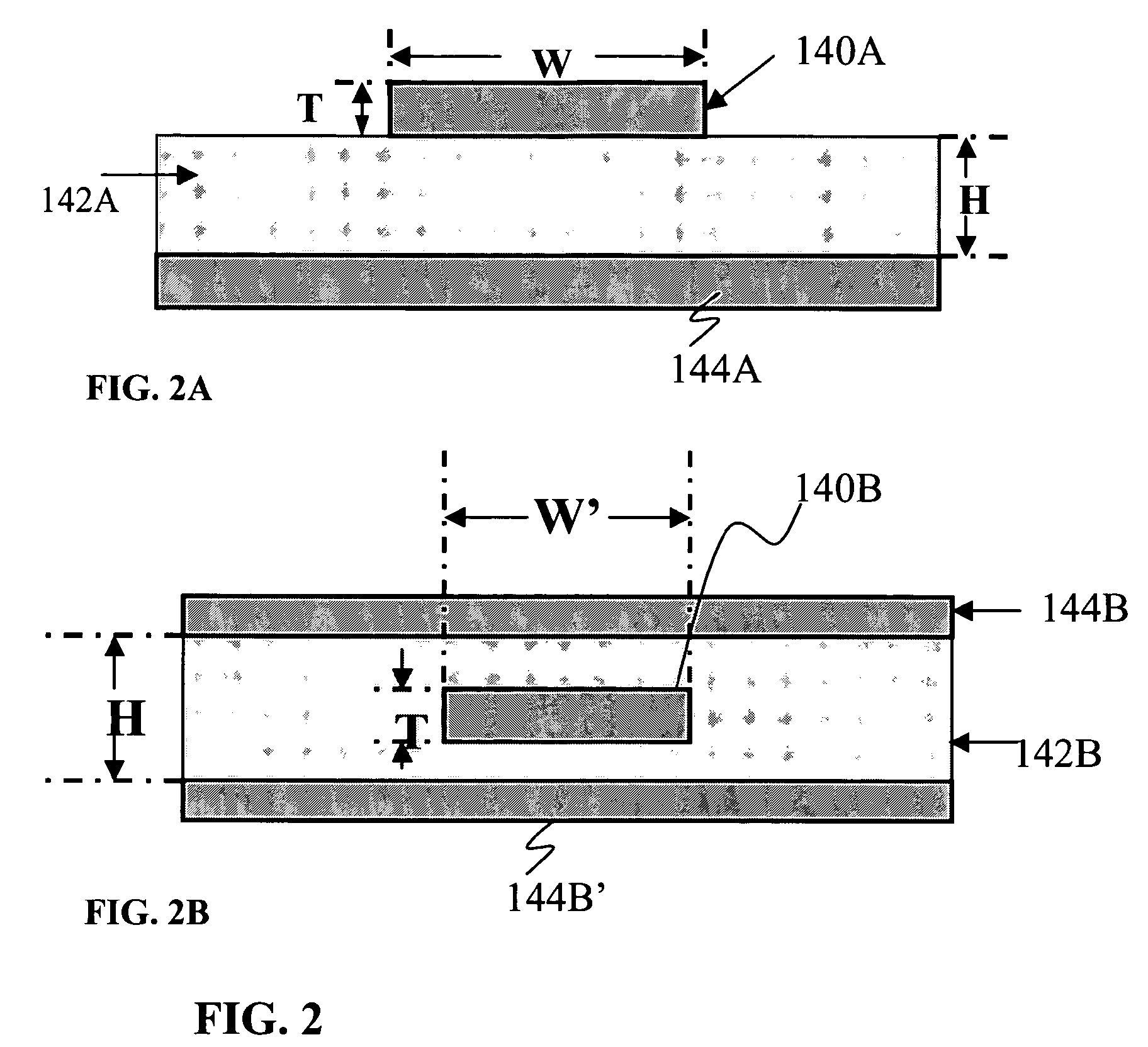High speed electrical interconnects and method of manufacturing
a technology of high-speed electrical interconnects and manufacturing methods, applied in the direction of electrical apparatus, semiconductor devices, waveguides, etc., can solve the problems of increasing difficulty in achieving simultaneous higher data rates and higher interconnect densities for both on-chip and also off-chip, increasing the difficulty of interconnecting electronic devices without sacrificing signal speed, and high-density interconnects. achieve the effect of reducing the effective loss-tangent of the interconnection system material, reducing the effective loss-tangen
- Summary
- Abstract
- Description
- Claims
- Application Information
AI Technical Summary
Benefits of technology
Problems solved by technology
Method used
Image
Examples
first embodiment
[0130]FIG. 3A is the top view and the FIGS. 3B and 3C are the cross-sectional views of a portion of the interconnects system, taken along AA′ direction of FIG. 3A in the first embodiment in accordance with the invention, wherein the same numerals represents the same parts so that repeated explanation is omitted here. Microstrip line as shown in FIG. 3A is laid onto dielectric system 148, having the opened trenches 150A (or 150B) into the dielectric system 148 located at the backside of the signal line 140A. The ground plan 152 is located on other dielectric system 148A′. The shape of the opened trenches 150A (and 150B) could be tetrahedral (square, rectangular or circular) or any shaped convenient for manufacturing, and the trenches are filled with the air or any dielectric materials having lower dielectric constant and lower loss tangent. This could be filled with the liquid crystal. By doing this, the refractive index can be tuned based on the electrical field. While signal flowin...
eighth embodiment
[0147]Other combination for placing signal lines on the dielectric system can also be possible. One of the example (not shown) could be the teeth of the upper substrate is front-back (vice-versa) direction, and the signal line is laid along the direction of left right (vice-versa). According to this invention, alternatively, different shape for the dielectric substrate (ground and signal lines) could be thought. One of the examples is the configuration, as shown in FIG. 10, with just opposite to FIG. 9. In FIG. 10, comb-shaped signal substrate 228, sandwiched by the comb-shaped ground substrate 230 (top side) and the thinner ground substrate 232 at the bottom side. In the eighth embodiment, as shown in FIG. 10, the position of the thinner ground plan is located at the bottom and in FIGS. The thinner dielectric substrate is located at the top. Also the teeth direction is downward in FIG. 10, whereas in FIG. 9 the teeth are in upward direction.
[0148]In the preferred embodiment, a port...
eleventh embodiment
[0151]According to this invention, for simplicity, only one microstrip structure with comb-shaped and uniform dielectric substrate are shown in FIG. 12, According to this invention, alternatively, different shape for the dielectric substrate (ground and signal lines) could be thought. One of the examples is the configuration, as shown in FIG. 13, with just opposite to FIG. 12. In the eleventh embodiment, as shown FIG. 13, uniform signal dielectric substrate 250 having the signal line directed towards downward direction, is stacked with comb-shaped dielectric substrate 252 having opening portion is directed in upward direction and the ground plan 144A is in opposite side of the comb-shaped substrate 252. The teethes 254 is in upward direction and the teethes 254 of comb-shaped dielectric substrate 252 directly touch the signal dielectric substrate 250. As explained in FIG. 12, the teeth can be arranged in a direction of front-back (FIG. 13) or left right (vice versa), and the signal ...
PUM
 Login to View More
Login to View More Abstract
Description
Claims
Application Information
 Login to View More
Login to View More - R&D
- Intellectual Property
- Life Sciences
- Materials
- Tech Scout
- Unparalleled Data Quality
- Higher Quality Content
- 60% Fewer Hallucinations
Browse by: Latest US Patents, China's latest patents, Technical Efficacy Thesaurus, Application Domain, Technology Topic, Popular Technical Reports.
© 2025 PatSnap. All rights reserved.Legal|Privacy policy|Modern Slavery Act Transparency Statement|Sitemap|About US| Contact US: help@patsnap.com



